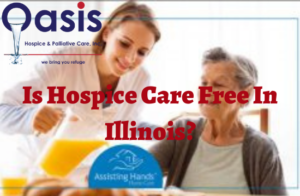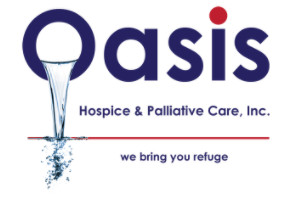Oasis hospice in Illinois offers the best services. For more information and assistance call (708) 564-4838
End-of-life decisions are never easy. They became significantly worse as a result of the COVID-19 epidemic, as many more people were forced to make those choices.
According to the Centers for Disease Control and Prevention, the United States will have 3,358,814 fatalities in 2020. The rate increased by 15.9 percent when adjusted for age. In 377,833 cases, COVID-19 was the underlying cause of death.
Second, the pandemic flipped the script on end-of-life care. There were bed, staffing, and equipment shortages. Thousands of patients died as a result of seclusion. Industry reforms are being prompted by the crisis.

“Failure to plan for adequate palliative and hospice care in the face of a significant increase in disease and death is unconscionable, as it risks undermining patient-family trust, long-term emotional health, and society’s core values,” the authors of a 2021 Journal of the American Medical Association article wrote.
Financial perplexity can exacerbate the sadness and bewilderment, as end-of-life decisions are made not just on the basis of a patient’s wants, but also on the basis of his or her financial capability. Here are some popular selections.
What Is Hospice Care?
End-of-life care refers to the treatment provided to someone nearing death in the final days, weeks, months, or occasionally years of his or her life.
Regardless of whether the patient’s disease is treatable or not, medical treatment and assistance are provided during this time. Many receive medical treatment from professionals in hospitals, nursing homes, or even their own homes.You can contact hospice illinois.
Patients are subsequently placed in palliative or hospice care, with Medicare, Medicaid, private insurance, charity, the person, or other payment schemes covering the costs.
The fact that Medicare covers 100 percent of hospice expenditures should be a strong incentive, but many eligible individuals do not utilize end-of-life services. According to a 2019 study published in the Journal of the American Geriatrics Society, around 2,700 Americans die each day without the assistance of hospice.
According to the survey, the “utilisation rate” is only 52.4%. If you are not already receiving hospice care or are considering doing so in the future, you are making a mistake.
Hospice care has been shown to improve patients’ and families’ mental health, increase survival time, alleviate strain on loved ones, and do a better job of keeping patients comfortable. Is Hospice care free in Illinos?
Palliative Medicine
Palliative care entails providing emotional support and practical assistance to someone facing a life-threatening illness while doctors and nurses work to find a cure. Palliative care begins with the diagnosis and continues until it becomes evident that the patient will die.
Hospice
Hospice is a term that refers to a type of care in which nurses, doctors, social workers, volunteers, and spiritual leaders collaborate to manage pain for terminally ill patients.
In contrast to palliative care, when a patient receives hospice care, they are no longer receiving treatment aimed at curing the illness. Doctors have exhausted those alternatives and are now focusing on symptom treatment.
Hospice is not geographically restricted. It may be provided in the home, an assisted living facility, a nursing home, a hospital, or a hospice institution.
According to a 2019 report by the National Hospice and Palliative Care Organization (NHPCO), almost 1.5 million Medicare enrollees received hospice care in 2018. Although figures for 2020 are not yet complete, it is possible that the number of beneficiaries has decreased.
According to a May 2020 survey conducted by the National Association for Home Care and Hospice (NAHC), 95 percent of hospice agencies had existing patients refuse visits out of fear of catching COVID-19.
According to the NHPCO, there were around 4,600 Medicare-certified hospice providers in 2018. Over 55% of providers had been qualified for ten years or more.
Reprieve Care
Respite care provides caregivers of terminally ill patients with a brief break. The patient may stay in a Medicare-approved nursing home, hospital, or hospice facility for up to five days.
End-of-Life Care Options
There are three major end-of-life care facilities:
Hospitals
Hospitals provide 24-hour medical care by doctors and nurses, a comprehensive range of treatment options, advanced medical equipment, multidisciplinary teams, and the possibility to obtain tests and life-saving operations.
Intensive Care Units (ICUs) and Coronary Care Units are examples of high-intensity hospital care (CCUs). Around 60% of Americans die in acute care hospitals, with 20% spending their last days in an intensive care unit.
Residential Care Facilities
Nursing homes, alternatively referred to as skilled nursing facilities, provide round-the-clock nursing care, however a physician is not usually on-site. According to the National Center for Health Statistics, the country has more than 17,000 nursing facilities that house more than 1.6 million inhabitants.
According to the United States Census Bureau, slightly more than 5% of the country’s 49.2 million seniors live in nursing homes. The residency ratios rise with age: 50% of individuals over the age of 95 reside there. In total, 20% of deaths in the United States occur in nursing facilities.
A Patient’s Residence
While eighty percent of Americans prefer to die at home, only about twenty percent really do. This disparity is largely explained by the challenges and costs associated with caring for a terminally ill patient at home; in the majority of cases, nursing care and specialised equipment are necessary.
However, in-home care is gaining popularity. According to a research conducted by the consulting firm ATI Advisory, the number of health insurers offering coverage for home-based palliative care climbed from 61 in 2020 to 134 in 2021.
Who Covers the Cost of End-of-Life Care?
Approximately 85 percent of the cost of end-of-life care is covered by various government institutions, including Medicare, Medicaid, and health care programmes provided by the Veterans Administration (VA) and the Department of Defense (DoD); as well as private medical and long-term care insurance.
Hospice costs are covered in the following ways: 85.4 percent by Medicare; 5% by Medicaid; 6.9 percent by managed care or private insurance; and 2.7 percent by others (including charity and self-pay).
Medicare
Under Parts A and B, Medicare is mandated to pay for all medically necessary hospital and physician care, regardless of cost or patient condition. 82 percent of the 2.854 million Americans who died in 2019 were Medicare members. Since 1982, the Medicare Hospice Benefit has covered qualifying patients’ treatment.
Eligibility for the Hospice Benefit under Medicare
- The patient must be at least 65 years old.
- Diagnosed with a life-threatening illness
- A doctor’s certification that he or she has six months or less to live
- Accepts to forego potentially curative or life-saving treatment
- Medicare must authorise hospice providers.
Medicare covers two 90-day hospice stays, followed by an unlimited number of 60-day stays. A doctor must recertify that the patient has six months or fewer to live at the start of each term of treatment.
Medicare’s hospice benefit covers a wide variety of services, including the following:
- Providing nursing care
- Services of a medical social worker
- Services provided by physicians
- Guidance (including dietary, pastoral and other types)
- Hospitalization
- Services of a hospice aide and a homemaker
- Medical instruments and supplies (including drugs and biologicals)
- Occupational and physical treatments
- Services in speech-language pathology
- Family bereavement services
- Medicare does not cover hospice care.
- Accommodation and board
- Costs associated with emergency treatment, such as ambulance fees or emergency department visits
- Treatment or prescription medications aimed at curing sickness
Medicaid
End-of-life care is fully covered for children with impairments and adults who fulfil Medicaid’s financial eligibility criteria. Medicaid can cover costs that Medicare does not cover, such as outpatient prescription medicines and long-term care, for Medicare beneficiaries who are dual eligible for both programmes (roughly 20% of all Medicare beneficiaries).
Medicaid and Medicare have nearly identical hospice eligibility requirements: patients must be certified to have six months or less to live and must receive care from a Medicare-approved hospice facility or agency. Medicaid policies, on the other hand, differ per state.
Along with hospice care, Medicaid covers at least 95% of the costs of room and board for hospice patients residing in a nursing home. The hospice agency receives the funds and then pays the care facility.
Insurance for Individuals
Private health insurance policies offer a wide range of coverage options. If the policy covers hospice, end-of-life care, or palliative care, the majority of these expenditures will be covered.
Not all insurance plans cover hospice care, but the majority do, as it is often significantly less expensive than hospital therapy. Certain policies that cover hospice treatment may impose a cap on hospice costs.
Additional Payers
TRICARE is a government-sponsored health care programme that offers health benefits to active-duty military troops, retirees, and their dependents. This programme covers hospice treatment.
CHAMPVA (Civilian Health and Medical Program of the Department of Veterans Affairs) is a Veterans Administration-sponsored health care programme that insures some deceased or disabled veterans’ eligible beneficiaries. It pays for the majority of medically essential care, including hospice care.
Individuals who do not have private health insurance or are not covered by a government policy are responsible for their own end-of-life care. Certain types of hospice treatment are reimbursable on a sliding scale or through philanthropic or other contributions.
End-of-Life Care Costs
In 2018, Americans spent $3.65 trillion on healthcare, with $365 billion going toward end-of-life care. The cost of hospitalisation was significantly higher than the cost of hospice care.
According to a 2019 study conducted by healthcare data analytics firm Trella Health, patients who did not elect hospice incurred an additional $27,455 in healthcare costs, compared to patients who received hospice care in their final months of life.
Individuals who receive hospice early in the course of their diseases save an average of $14,000 in health care costs over the final three months of life when compared to patients admitted for a short-term stay.
“The data indicates that hospice is grossly underestimated in terms of the value it generates,” Trella CEO Ian Juliano stated. “I am unaware of any other care setting that offers anything close to that level of return for such a minimal investment.
“It is a truly unique care setting, and it is abundantly clear that it provides an excellent return on investment for the payer, who is typically the taxpayer.”

